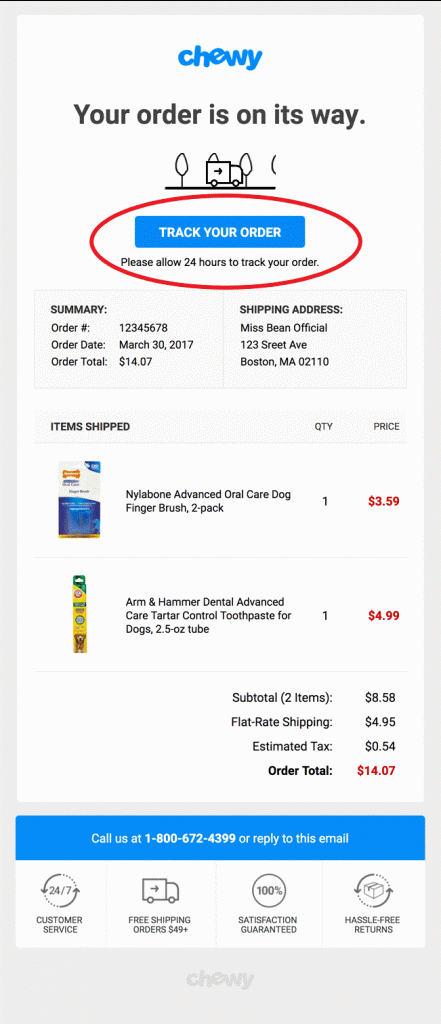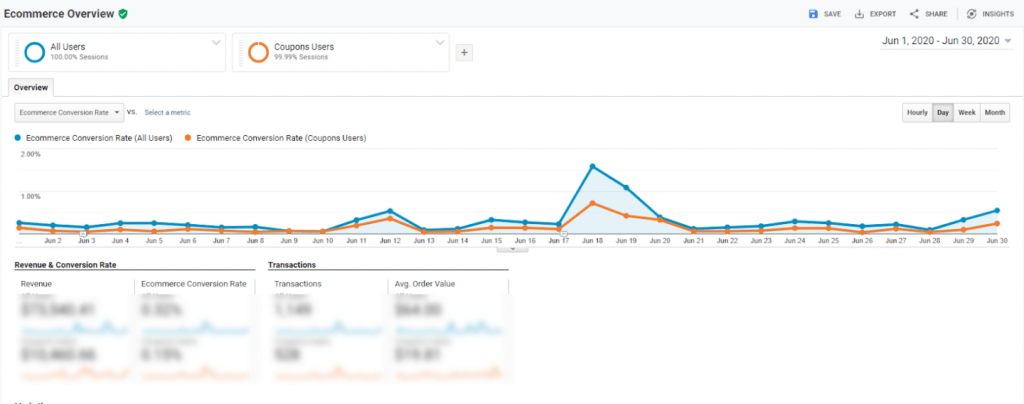6 Useful Order Tracking Strategies to Boost eCommerce Sales


Subscribe now! Receive 15% discount.
Don’t miss out – get 15% off your first order when you join the newsletter. It’s fast, free, and kinda smart.
You're now subscribed!
In this article:
Seasoned eCommerce marketers know the value of optimising their post-purchase experience.
According to 70% of retailers, setting the right expectations about delivery and package tracking is key.
Another report suggests that 96% of shoppers want retailers to identify and resolve package problems while in transit.
40% of shoppers consider the post-purchase experience to be the most memorable part of the brand experience.
The point is simple:
Your post-purchase experience can also be a profitable marketing channel.
To that end, in this article, you'll learn:
- What is order tracking, and what its benefits are?
- Tips and strategies to use order tracking as a revenue-boosting marketing channel.
- How real-life brands can optimise their marketing efforts and enhance user happiness.
Let's jump right in, starting with the most basic question:
What is Order Tracking?
Quite simple, order tracking is an online tool which:
- Offers buyers information about their purchased product
- Allows buyers to see the status of their order--whether it is still in the warehouse or whether it is on the way
- Brings about greater transparency and visibility into the delivery process.
Now that you have a basic understanding of what order tracking entails, let's deep-dive and see its benefits.
Top-4 Benefits of Order Tracking
Order tracking has emerged as an essential component of the eCommerce marketing process (and for good reason).
Here's a quick snapshot of its all-round benefits.
Reduced costs
By implementing eCommerce order tracking, the volume of your customer inquiries is bound to go down.
Furthermore, customers can self-serve and address their queries themselves, making it a win-win for all as costs are reduced.
Lower workload
Automating the order tracking process ensures there's less workload on your CX team.
They can use this saved time to offer personalised service to disgruntled customers.
All in all, your customer experience becomes seamless without compromising on quality.
Happier customers
A streamlined and proactive tracking process results in satisfied customers. Plus, it boosts user engagement.
All types of eCommerce businesses should offer updates throughout the shipping process.
This improves user happiness, loyalty, and satisfaction.
As per data, "53% of US online shoppers won’t purchase a product if they don’t know when it will arrive."
Control over order fulfilment
On the business side, the tracking order information is important.
It allows eCommerce businesses to address issues in real-time and on-the-spot, ultimately improving the efficiency and accuracy of their order
fulfilment process.
As moments of friction get minimised, the lifetime value of your customers will skyrocket.
By extension, so will sales.
Order tracking offers 360-degree benefits for the eCommerce business as well as the customer.
It is well worth the investment and effort, and may even be included if you use a third-party fulfilment centre.
Let's look at how you can improve your existing delivery process and super-charge it.
Top-6 Ways to Use Order Tracking for Boosting eCommerce Sales
1. Transform Shipment Tracking to Shipment Marketing:
The problem: eCommerce businesses provide little to no visibility into the shipping process.

Proposed solution:
Identify the interactive touch-points throughout the delivery process, which can be re-marketed.
Collect real-time data (think: customer contact and name, order information, tracking number, package movements).
Send the compiled data to your brand's email marketing platform to segment and personalise the information.
Integrate data into your marketing efforts, such as shipment tracking emails, SMS, live chat.
Tracking notification emails boast open rates of 50% to 120%.
How can you take your shipment marketing initiatives to the next level?
Here are a few handy tips.
Best-Practices to Follow Shipment Marketing:
- Be proactive, provide detailed tracking updates, and ensure that your messaging is personalised, as solestruck demonstrates below:

- Feature your live social media feed, highlight your brand's new products in the tracking email page, or offer personalised product suggest as Crate&Barrel does brilliantly:

- Offer an estimate of expected delivery to put your customer's mind at ease and reduce support inquiries:

- Encourage users to post on social media with your brand's customised hashtag on the shipment tracking page:

Rethink your shipment tracking experience as a channel for personalised marketing and connect with your users on a more intimate level.
2. Integrate Live Chat for Solving Tracking-related Queries in Real Time:
The problem: Most customers complain about not having an option to connect with customer support in real-time.
In fact, 51% of consumers want real-time visibility into the status of their orders.
Proposed solution: Integrate live chat software into your website to:
- Troubleshoot problems in real-time and answer customer queries instantly:

- Empower customers to self-serve as the Toys R Us' bot, Emma demonstrates below:

- Offer relevant and useful information to common customer queries. Canyon Bikes uses live chat to offer useful information to customers in real-time:

- Collect critical user data such as the customer's pain-points, buying preferences, behaviour pattern. Plus, it offers insights into customer expectations and identifies gaps in the user experience. Take a look at Warby Parker's live chat example:

- Offer immediate, one-to-one interactions and enhance the user's tracking experience as shown below by a ModCloth advocate:

Live chat paves the way for proactive and accurate tracking notifications, making it a marketing win in the customer's eyes.
3. Appreciate Customers with Every Purchase Through Small Gestures:
The problem: According to research, 43% of shoppers want retailers to reward their loyalty by personalising the delivery experience.
Lack of personalisation poses a serious problem.
The solution: Win customers over with free samples and other freebies in the order tracking email, particularly if they are new or loyal customers.
Here's an example of an order tracking email from The Earth Collective for reference:

- Integrate a "progress" bar and gamify the tracking process as Apple's email does:

- Offer customers the flexibility to choose where they would like to receive the order updates as Gap does:

- Offer personalised suggestions and highlight the product reviews to upsell or cross-sell:

- Send hand-written thank-you notes to the customer as they receive the order and prioritise customer retention
- Integrate Google Maps and offer greater visibility into order updates:

There are innumerous ways to personalise the order tracking page.
The idea is to first gather useful customer data.
This information can then be used to add value to your communication through small-yet-significant features, as you saw above.
4. Utilise Business Intelligence Tools for Cost-Saving Opportunities:
The problem: eCommerce businesses have to constantly deal with the ever-widening gap between delivery processes and logistics management.
This is also hampering productivity as well as profitability.
The solution: Leverage an eCommerce delivery tracking management software that allows businesses to track shipments and parcels throughout the customer journey.
It should also offer:
- Granular visibility from the first mile to the last mile
- Automatically assigns pickup and delivery tasks to agents and helps them collect e-Signatures from customers
- The ability to drive hassle-free and seamless delivery operations, with real-time tracking and management functionalities:

- Optimised route planning capabilities and ensures accurate utilisation of resources
- Benefits such as reduced delivery delays and turn-around time
- Intelligent live tracking devices such as disposable GPS stickers to track packages
- Cost-saving due to end-to-end delivery tracking optimisation
- A bird’s eye view of the entire delivery and tracking operation, ensuring greater transparency and scalability:

Best-Practices to Consider When Selecting a Shipping Software
Ask yourself the following questions when buying shipping software:
- Is it compatible with your existing logistics system, and will it integrate seamlessly?
- Is the software safe and secure in terms of data breaches and cyber-attacks? Does it offer state-of-the-art security features?
- Does it offer critical information in real-time such as temperature changes, humidity, damage to the product?
- Is it scalable, and does it offer multi-channel support?
- Is the design and UX user-friendly?
There are several intelligent tools available that eCommerce marketers can use to automate simplified tasks that do not require a 'human touch.'
This allows them to save on resources, cost, time, and effort while providing customers with a stellar experience.
5. Leverage Google Analytics and Target Repeat Purchasers with Customised Offers and Discounts:
The problem: eCommerce marketers often struggle with problems such as an abandoned cart, engaging with existing users, and converting on-the-fence customers to make purchases.
In fact, data predicts that the eCommerce brand loses a staggering $18 billion in sales revenue every year due to abandoned cart.
The solution: Start using the multi-purpose Google Analytics tool to:
- Learn about your customer's shopping behaviour on-site and then roll out relevant coupons and deals to close the purchase:

Data claims that customers are willing to make larger, higher-valued purchases if they have a coupon at hand.
- Offer discount codes and offers in the order tracking email (for the next purchase) as JC Penny does:

Or send offers along with your order tracking SMS:

- Collate coupon information from your website/in-person and feed it into your CRM software.
- Engage in customer tracking if the coupon is redeemable via a third-party, which may often be the case in eCommerce.
Once you've tracked and analysed the coupon usage, you can answer useful questions:
- Which channels do users use to redeem coupons?
- Which products do customers view more often to use the coupons?
- Which coupons have the best ROI?
- Do users who make use of coupons spend more than those who don't?
And so on.
People like free stuff. Period.
However, the trick lies in segmenting and targeting the 'right user' at the right time.
This is where a web analytics platform such as Google Analytics can lend a helping hand and boost your bottom line.
6. Collect Feedback from Users and Track for Improvement for Future Campaigns:
The problem: eCommerce marketers do not actively collect feedback from users to understand what's working for their brand (and what isn't).
This inability to track customer-centric data does not allow them to improvise and better their customer experience.
The solution: Marketers should look at innovative ways to collect user feedback at all touch-points in the buyer journey.
Crate & Barrel makes an interesting case in point:

It allows customers to rate their shipping experience and understand where the brand can do better.
- You can also showcase customer testimonials as Crutchfield does to get 'social proof' and instil greater trust and confidence among your customers:


Marketers can gather information related to a host of topics such as:
- Preferred shipping time:

- Overall shipping experience (whether it was seamless or incoherent)
- Preferred shipping method:

Gathering real-time user feedback is essential for eCommerce marketers to understand where they might be lacking in the customer as well as shipping-experience and bridge the gap.
As a result, eCommerce businesses should constantly focus on gather customer feedback and analyse the data to extract meaningful insights and drive powerful marketing campaigns.
Wrapping Up
Interactions and marketing around shipment tracking can help eCommerce brands stand out.
In other words, it serves as a competitive advantage for eCommerce businesses who can personalise the experience and use real-time data all through the customer journey.
Additionally, e-Marketers need to embrace a change in mindset and rethink their shipping strategies from a marketing as well as customer support perspective.










